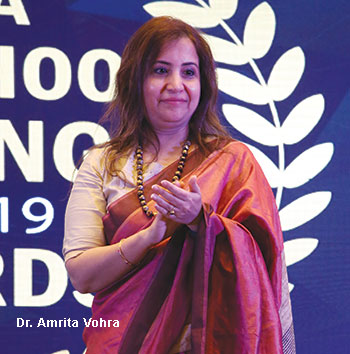Dr. Amrita Vohra – Progress & differentiated instruction in early childhood
 Loris malaguzzi (1920-1994), the Italian pedagogist and designer of the Reggio Emilia early childhood approach to education, wrote in a poem titled ‘No way. The hundred is there’ that every child has a hundred languages and hundred ways of thinking, playing and making sense of the world, i.e, each child is different and learns differently.
Loris malaguzzi (1920-1994), the Italian pedagogist and designer of the Reggio Emilia early childhood approach to education, wrote in a poem titled ‘No way. The hundred is there’ that every child has a hundred languages and hundred ways of thinking, playing and making sense of the world, i.e, each child is different and learns differently.
Early childhood educators need to not only read Malaguzzi but also internalise his message. Young children greet us every day with radiant faces full of curiosity. Are we listening to and letting their hundred languages co-exist? These hundred languages co-exist in our classrooms together with challenging impediments: difficult and demanding parents, intense competition, teacher attrition, unwieldy syllabus, among others.
A child stepping into a pre-primary for the first time has already learned to walk and use language to communicate. She didn’t need a structured curriculum to accomplish this. Homo sapiens are born with the innate capability and desire to learn, marvel and love. When an infant is learning to walk, ‘learning’ itself is the reward of learning. To achieve this feat, she undoubtedly fell down several times, got up and tried again, voluntarily accepting the challenge every time, undeterred by failure. Parents and teachers didn’t need to encourage or reward her. Learning happened at its own pace, for its own sake, and will last a lifetime.
In early years classrooms, this innate ability and desire of children to learn needs to coalesce with development of literacy, numeracy, motor coordination, aesthetic development and socio-emotional skills. Teachers can use and facilitate the natural capability of children to learn. Extensive research conducted by John Hattie, professor of education at the University of Melbourne, Australia, indicates that ‘constructive feedback’ has the highest impact on improving learning outcomes. However, empty praise like ‘A+’ ‘star’ or ‘smiley’ don’t constitute constructive feedback. These can be positive reinforcements at best. Feedback needs to be specific to performance and appreciative of the effort, rather than outcome.
Children can control effort and develop ‘growth mindsets’, but not innate abilities. However, labels like ‘you are talented/smart’ lead to ‘fixed mindsets’ that could hinder learning. Dr. Carol Dweck, professor of psychology at Stanford University, who developed the growth mindset learning theory, says when students are made to believe they can improve their intelligence, ability and performance, they invest the extra time and effort that leads to higher achievement. The opposite, a fixed mindset, refers to the belief that a person’s abilities are preordained.
Yet while empty praise can induce complacency and limit progress, punishment is worse. Maria Montessori famously said: “If a child has to be rewarded or punished, it means he lacks the capacity to guide himself.” Therefore, an important Montessori principle is built-in ‘control of error’ in learning materials and all aspects of the learning environment, which enables children to evaluate their own work. When a child is able to self-assess her work, she builds the foundation of independent and satisfying learning. In Montessori pedagogy, the teacher’s role is of an informed observer facilitating, rather than dictating, learning.
In ECCE (early childhood care and education), if free play is encouraged and goal-setting and self-assessment tools such as rubrics and didactic learning materials are provided, children transform into amazing facilitators for their peers. And there’s a considerable body of research which indicates that peer learning enables every child to become an MKO (more knowledgeable other) for her peers. Such empowerment of learners in ECCE helps children assume responsibility for their own learning and engage in self-driven efforts to accomplish challenging tasks.
Therefore, early years teachers need to create learning environments with age-appropriate stimuli and facilitate exploration and discovery through free play, heuristic and guided play to stimulate the development of multiple intelligences of children. Instead of being the conventional sage on stage, early childhood teachers wear two hats. They do dramatic presentations and are keen researchers.
For teachers, it’s important to bear in mind that our children teach us so we can teach them. Thus, teachers reflecting on their own classroom practices with peers, students and parents is the best way to ensure effective professional development. “This is the only kind of educational research that will ever actually improve education — research done by teachers, in their own classrooms, to solve what they see as their own problems,” says John Holt, American educator and best-selling author (How Children Fail, 1964). The ‘joint practice development’ theory developed by Professor David Hargreaves, British educator and fellow of Wolfson College, Cambridge University, also endorses the peer-to-peer learning model fused with practice, as the most effective way to nurture great teachers.
As we reflect with peers, work with our teacher portfolios, set goals and self-assess against defined standards, we genuinely learn. Just like children, teachers need to reflect and learn from their mistakes, and enable the holistic development of children in stress-free learning environments.
(Dr. Amrita Vohra is the Gurgaon-based senior education specialist (India), Opportunity International)
Also read: 25 Leaders reinventing K-12 education – Dr. Amrita Vohra
















Add comment